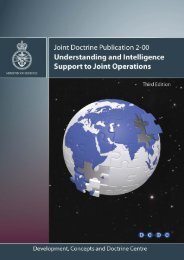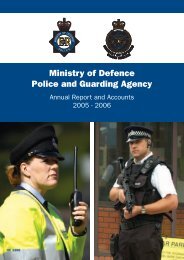maa workstream 3 rewrite military aviation regulations
maa workstream 3 rewrite military aviation regulations
maa workstream 3 rewrite military aviation regulations
You also want an ePaper? Increase the reach of your titles
YUMPU automatically turns print PDFs into web optimized ePapers that Google loves.
© Crown Copyright 2011<br />
MAA WORKSTREAM 3<br />
REWRITE MILITARY AVIATION REGULATIONS<br />
Briefing material for the use of commanders, managers<br />
and supervisors of those staff who are subject to<br />
regulation by the UK Military Aviation Authority
Scope<br />
� Catalyst for Change – XV230<br />
� Workstream 3 Requirement<br />
© Crown Copyright 2011<br />
● SRO Intent<br />
● Scope<br />
� Approach<br />
� Delivering the New Look<br />
� Next Steps<br />
� What does it mean for you?<br />
� Summary
Catalyst for Change<br />
� Nimrod Review report delivered end Oct 2009.<br />
� SofS statement to parliament mid Dec 2009<br />
© Crown Copyright 2011<br />
● SofS responded to the 84 recommendations as follows :<br />
- 64 Accepted in full<br />
- 16 Accepted in principal or with some modification<br />
- 4 Rejected<br />
� MAA will be audited at 2 year point by independent<br />
body<br />
● Focussing on how those accepted recommendations have<br />
been met
Workstream 3 Requirement<br />
� Issue: In Nimrod Review Report, H-C described Regulation and<br />
policy . . .<br />
© Crown Copyright 2011<br />
● “... of Byzantine complexity...”, “... impenetrable...”<br />
� Nimrod Review Recommendations:<br />
● 3 clear recommendations about overhauling and re-writing<br />
the current <strong>military</strong> [airworthiness] <strong>aviation</strong> regulation<br />
document set<br />
� Outline Requirement: WS3 will produce a new regulatory<br />
framework and concise document set within the air<br />
environment focussed on risk-to-life that will be easy to read,<br />
teach, assimilate and apply, and which clearly articulates how<br />
Air Safety is governed within the MOD.
Scope<br />
� MARSB Op Manual/MAA Charter<br />
� JSP 550<br />
� JSP 551<br />
� JSP 552<br />
� JSP 553<br />
� JSP 554<br />
� JSP 556<br />
� JAP 100A-01/02<br />
� AvP67<br />
� Process Def Stans 05-122, 05-123, 05-130<br />
� Regulatory Instructions<br />
© Crown Copyright 2011
Workstream 3 - Approach<br />
� Large scale and complexity of requirement was recognised and<br />
use of external technical support sought<br />
● Niteworks engaged in Sep 10<br />
� Initiation Phase Complete by Dec 10<br />
© Crown Copyright 2011<br />
● Included workshops and benchmarking activity<br />
● Framework, Regulatory Article (RA) format, process delivered<br />
� Execution phase in progress and is produced:<br />
● The new regulatory material to form the MAA Regulatory<br />
Publications (MRP)<br />
- Produced by a combined MAA/Niteworks team<br />
● Implementation/Roll-out plan<br />
● Recommendations for smarter tools for access/search, etc
Delivering the New Look<br />
� Timeline<br />
� Framework<br />
� Structure<br />
� Language<br />
© Crown Copyright 2011
Timeline<br />
� 26 May 11 – Niteworks delivered final drafts<br />
© Crown Copyright 2011<br />
● Allowed 5 weeks for MAA to undertake further assurance<br />
and prepare for publication<br />
� 1 Jul 11 – MAA owned and published MRP<br />
● 1 month allowed for familiarization<br />
� 1 Aug 11 – New <strong>regulations</strong> come into force<br />
● Replaced MARDS/Def Stans will become obsolescent<br />
● Allow 5 months (until 31 Dec 11) for subordinate policy,<br />
orders and instructions to reflect new references<br />
� From 1 Aug 11, routine amendment process will<br />
apply
INPUT<br />
MATERIAL<br />
POLICY<br />
Revised Framework<br />
REGULATORY<br />
ARTICLES<br />
MANUALS<br />
JSP 550<br />
© Crown Copyright 2011<br />
JSP 556<br />
Manual of<br />
Air Safety<br />
AvP 67<br />
JSP 551<br />
Vol 1<br />
Manual of<br />
Post Crash<br />
Management<br />
JSP 551<br />
Vol 2<br />
JSP 551<br />
Vol 3<br />
JSP 552<br />
JSP 554<br />
JAP 100A-<br />
01/02<br />
JSP 553<br />
MAA01: MAA REGULATORY POLICY<br />
MAA02: MAA MASTER GLOSSARY<br />
MAA03: MAA REGULATORY PROCESSES<br />
DefStan<br />
05-122<br />
1000 Series: GENERAL REGULATIONS (GEN1000)<br />
2000 Series:<br />
FLYING<br />
(FLY2000)<br />
Manual of<br />
Flying Orders<br />
for Contractors<br />
Manual of<br />
Military Air Traffic<br />
Management<br />
3000 Series:<br />
AIR TRAFFIC<br />
MANAGEMENT<br />
(ATM3000)<br />
Manual of<br />
Aerodrome<br />
Design and<br />
Safeguarding<br />
DefStan<br />
05-123<br />
DefStan<br />
05-130<br />
4000 Series:<br />
CONTINUING<br />
AIRWORTHINESS<br />
ENGINEERING<br />
(CAE4000)<br />
Manual of<br />
Maintenance and<br />
Airworthiness<br />
Processes<br />
MARSB<br />
Op Manual<br />
Regulatory<br />
Instructions<br />
5000 Series:<br />
DESIGN AND<br />
MODIFICATION<br />
ENGINEERING<br />
(DME5000)<br />
Manual of Maintenance<br />
and Airworthiness<br />
Processes – MOD Form<br />
700 Series of Forms
RA 2130 - SAFETY AND SURVIVAL DRILLS<br />
Rationale<br />
© Crown Copyright 2011<br />
Aircrew operating UK Military Aircraft are to have a thorough working knowledge of all<br />
emergency procedures, safety equipment and survival aids appropriate to their aircraft<br />
type and role.<br />
Contents 2130(1): Emergency and Survival Training<br />
2130(2): Emergency and Survival Training Currency<br />
2130(3): Wearing and Carriage of Aircrew Equipment Assemblies<br />
(AEA) and Safety Equipment (SE)<br />
2130(4): Safety Harnesses<br />
2130(5): Survival and Rescue Equipment<br />
2130(6): Ejection Seat Anthropometrics<br />
Regulation<br />
2130(1)<br />
2130(2)<br />
Acceptable<br />
Means of<br />
Compliance<br />
2130(1)<br />
2130(2)<br />
Guidance<br />
Material<br />
2130(1)<br />
2130(2)<br />
Emergency and Survival Training<br />
2130(1) On conversion to a new aircraft type all aircrew shall<br />
complete the appropriate emergency and survival drill training<br />
mandated by Aviation Duty Holders and Commanders.<br />
Emergency and Survival Training Currency<br />
2130(2) Qualified aircrew required to fly as crew shall be responsible<br />
for keeping themselves in date for all survival and emergency<br />
drills, including those required for embarked operations,<br />
appropriate to aircraft type and role.<br />
Emergency and Survival Training<br />
1. Aviation Duty Holder and Commanders’ Orders covering survival and<br />
emergency drills should include, where necessary, the following:<br />
a. The category into which each unit under their command falls for the<br />
periodicity of drills table at Annex A.<br />
b. Any additional requirement or change in periodicity to that indicated at<br />
Annex A.<br />
c. The procedures to be followed when a dispensation or extension is<br />
deemed necessary.<br />
d. The survival and emergency drill requirements for supernumerary<br />
crew, passengers and for familiarization flights.<br />
Emergency and Survival Training Currency<br />
2. The maximum periodicity of drills is promulgated in Annex A to this Regulatory<br />
Article.<br />
Emergency and Survival Training<br />
3. Emergency Drills. Standard emergency drills for forced landings, ditching and<br />
abandoning an aircraft by parachute are included in the Aircraft Document Set (ADS)<br />
and will be complied with.<br />
4. Abandon Aircraft Drill on the Ground. The abandon aircraft drill will be<br />
Example<br />
Regulatory<br />
Article
RA 2130 - Safety and Survival Drills<br />
Rationale<br />
© Crown Copyright 2011<br />
Aircrew operating UK Military Aircraft are to have a thorough working knowledge of all<br />
emergency procedures, safety equipment and survival aids appropriate to their aircraft<br />
type and role.<br />
Contents 2130(1): Emergency and Survival Training<br />
2130(2): Emergency and Survival Training Currency<br />
2130(3): Wearing and Carriage of Aircrew Equipment Assemblies<br />
(AEA) and Safety Equipment (SE)<br />
2130(4): Safety Harnesses<br />
2130(5): Survival and Rescue Equipment<br />
2130(6): Ejection Seat Anthropometrics<br />
Regulation<br />
2130(1)<br />
2130(2)<br />
Emergency and Survival Training<br />
2130(1) On conversion to a new aircraft type all aircrew shall<br />
complete the appropriate emergency and survival drill training<br />
mandated by Aviation Duty Holders and Commanders.<br />
Emergency and Survival Training Currency<br />
2130(2) Qualified aircrew required to fly as crew shall be responsible<br />
for keeping themselves in date for all survival and emergency<br />
drills, including those required for embarked operations,<br />
appropriate to aircraft type and role.
Acceptable<br />
Means of<br />
Compliance<br />
2130(1)<br />
2130(2)<br />
Guidance<br />
Material<br />
2130(1)<br />
2130(2)<br />
© Crown Copyright 2011<br />
Emergency and Survival Training<br />
1. Aviation Duty Holder and Commanders’ Orders covering survival and<br />
emergency drills should include, where necessary, the following:<br />
a. The category into which each unit under their command falls for the<br />
periodicity of drills table at Annex A.<br />
b. Any additional requirement or change in periodicity to that indicated at<br />
Annex A.<br />
c. The procedures to be followed when a dispensation or extension is<br />
deemed necessary.<br />
d. The survival and emergency drill requirements for supernumerary<br />
crew, passengers and for familiarization flights.<br />
Emergency and Survival Training Currency<br />
2. The maximum periodicity of drills is promulgated in Annex A to this Regulatory<br />
Article.<br />
Emergency and Survival Training<br />
3. Emergency Drills. Standard emergency drills for forced landings, ditching and<br />
abandoning an aircraft by parachute are included in the Aircraft Document Set (ADS)<br />
and will be complied with.<br />
4. Abandon Aircraft Drill on the Ground. The abandon aircraft drill will be
RA 1005 – Competent Organizations and Responsibilities<br />
Rationale<br />
© Crown Copyright 2011<br />
MOD policy is to only procure from contractors who have been assessed as<br />
competent.<br />
Contents 1005(1): Competent Organizations and Responsibilities<br />
Regulation<br />
1005(1)<br />
Acceptable<br />
Means of<br />
Compliance<br />
1005(1)<br />
Guidance<br />
Material<br />
1005(1)<br />
Competent Organizations and Responsibilities<br />
1005(1) PTLs shall only contract with competent organizations.<br />
1. The PTL should only contract with design organizations approved under the<br />
Design Approved Organization Scheme.<br />
2. The PTL should only contract with maintenance organizations approved under<br />
the Maintenance Approved Organization Scheme. At present the current scope of the<br />
MAOS is restricted to Mil Pt 145 approval for all on-aircraft contractor depth<br />
maintenance and off-aircraft maintenance carried out on government property. Within<br />
this current restriction, all Air Domain platform and equipment PTs should contract for<br />
continuing airworthiness activities with MAOS Mil Pt 145 approved organizations.<br />
Design Approved Organization Scheme (DAOS)<br />
3. It is MOD Policy to procure only from contractors who have been assessed as<br />
competent to design and supply aircraft or airborne equipment to a satisfactory<br />
standard. As a pre-requisite to a DAOS approval, such contractors will have achieved<br />
ISO 9001:2000 third party certification (or acceptable equivalent) with an appropriate<br />
scope that has been accredited by the United Kingdom Accreditation Service (UKAS)<br />
or by an overseas equivalent that is a signatory to either The International<br />
Accreditation Forum – Multi Lateral Agreement or The European Co-operation for<br />
Accreditation - Multi Lateral Agreement.<br />
4. The MOD Design Approved Organizations Scheme (DAOS), defined more fully<br />
in RA5101, provides PTL with assurance of a contractor’s suitability to undertake a<br />
defined scope of design activity or Post Design Services (PDS) activity. DAOS<br />
approval will only be awarded following a successful assessment of a contractor or<br />
Service organization by the MAA or its appointed agents. Successful Design<br />
Organizations (DO) will be added to the DAOS register, which is maintained by the<br />
MAA and can be viewed at www.daos.dii.r.mil.uk.<br />
5. DAOS approval is a mandatory requirement. Accordingly, the MAA requires all<br />
platform and equipment PTs to contract/ task for aircraft & associated equipment,<br />
airborne weapon and electronic systems (including PDS) with organizations approved<br />
under DAOS. Note that the responsibility for assurance of the adequacy of subcontractors<br />
involved in design activities rests with the prime design organisation.<br />
There is no intention to universally mandate the DAOS at sub-contractor level, there<br />
is, however, a requirement for signatories of Certificates of Design (C of D) to be<br />
approved for the purpose under DAOS.<br />
6. Unless already in place each PTL will include a transition plan in their<br />
airworthiness strategy, to meet this mandate. The strategy will be monitored and<br />
reviewed by the Operating Centre Directors at the Airworthiness Review for the<br />
equipment.<br />
Example<br />
Regulatory<br />
Article
RA 1005 – Competent Organizations and Responsibilities<br />
Rationale<br />
© Crown Copyright 2011<br />
MOD policy is to only procure from contractors who have been assessed as<br />
competent.<br />
Contents 1005(1): Competent Organizations and Responsibilities<br />
Regulation<br />
1005(1)<br />
Acceptable<br />
Means of<br />
Compliance<br />
1005(1)<br />
Guidance<br />
Material<br />
1005(1)<br />
Competent Organizations and Responsibilities<br />
1005(1) PTLs shall only contract with competent organizations.<br />
1. The PTL should only contract with design organizations approved under the<br />
Design Approved Organization Scheme.<br />
2. The PTL should only contract with maintenance organizations approved under<br />
the Maintenance Approved Organization Scheme. At present the current scope of the<br />
MAOS is restricted to Mil Pt 145 approval for all on-aircraft contractor depth<br />
maintenance and off-aircraft maintenance carried out on government property. Within<br />
this current restriction, all Air Domain platform and equipment PTs should contract for<br />
continuing airworthiness activities with MAOS Mil Pt 145 approved organizations.<br />
Design Approved Organization Scheme (DAOS)<br />
3. It is MOD Policy to procure only from contractors who have been assessed as<br />
competent to design and supply aircraft or airborne equipment to a satisfactory<br />
standard. As a pre-requisite to a DAOS approval, such contractors will have achieved<br />
ISO 9001:2000 third party certification (or acceptable equivalent) with an appropriate<br />
scope that has been accredited by the United Kingdom Accreditation Service (UKAS)
Language is a Key Element<br />
� Mandatory v Permissive wording<br />
� Military Orders v Civil Interoperability<br />
© Crown Copyright 2011<br />
● “Is to”/”Are to” versus “Shall”<br />
� Agreed language:<br />
● SHALL: The word “Shall” is reserved solely for use in <strong>regulations</strong><br />
and orders.<br />
● RATIONALE: The origin/reason of a regulation can be given in a<br />
text after a regulation behind the word “Rationale”.<br />
● SHOULD: The word “Should” is reserved solely for use in<br />
Acceptable Means of Compliance.<br />
● MUST/WILL/MAY/COULD/CAN: These words are most often used<br />
in Governance and Guidance material.<br />
� Definition of Terms<br />
● Common glossary and use of abbreviations
Access to the New Regulatory Suite<br />
� Initially documents will be in Adobe (PDF) format<br />
� Available via Defence intranet and internet<br />
© Crown Copyright 2011<br />
● Access through the respective MAA websites<br />
● MAA ASPPIC team are the publishing agents<br />
� In a form that could be printed if that is what the end<br />
user requires (with their resources and cost)<br />
� Production of one-off CD versions.
WS3 – The Works<br />
� What the MAA has delivered is a vast improvement in terms of<br />
the ease to which users will be able to read, teach, assimilate<br />
and apply Military Aviation Regulations – but . . .<br />
© Crown Copyright 2011<br />
. . . . this is only the first step!<br />
� Having delivered the basic <strong>rewrite</strong>, the MAA will:<br />
● Continue to introduce new regulation as output from other<br />
<strong>workstream</strong>s<br />
● Fill gaps/inconsistencies identified<br />
● Possible re-work as user feedback received<br />
● Improve interim accessibility within Dii limitations<br />
● Look to deliver in a modern e-publishing format<br />
- eg ‘SKYbrary’ [live link] or [screen shot] (target by end FY11/12)<br />
● Tackle other ‘out of scope’ publications
What does this mean for you?<br />
� The additional clarity will make it easier to determine what you<br />
and your staff are required to do.<br />
� References in policy documents, order books, training<br />
material and other guidance material will need to be updated.<br />
© Crown Copyright 2011<br />
● A cross-referencing tool will be provided<br />
� Legacy MARDS and process Def Stans will become<br />
obsolescent on 1 Aug 11<br />
● Contracts referencing the legacy standards/<strong>regulations</strong> will still be<br />
valid but MRP should be considered for new contracts/contract<br />
review<br />
� You will need to ensure you staff are aware of the new location<br />
and format of the new MRP<br />
● This can be supported by MAA briefings to your senior staff and<br />
this cascade briefing material
Key Messages<br />
� WS3 has delivered a new regulatory framework and concise<br />
document set within the air environment focussed on risk-tolife<br />
that will be easy to read, teach, assimilate and apply, and<br />
which clearly articulates how Air Safety is governed within the<br />
MOD<br />
� Regulation separate from AMC/GM<br />
� Info on single topic in one place<br />
� Single set of MRP for MOD and industry<br />
� Significant restructure/format but less than 5% of <strong>regulations</strong><br />
changed<br />
� First pass of a multi-stage process<br />
� MRP will provide the regulatory framework from 1 Aug 11<br />
© Crown Copyright 2011
What content has changed? (
Any Questions<br />
© Crown Copyright 2011
© Crown Copyright 2011


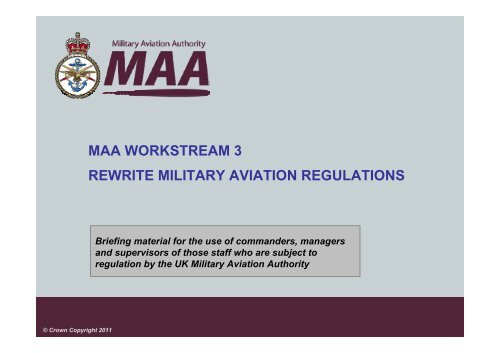
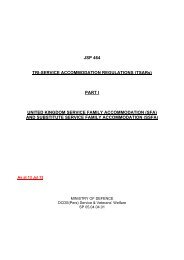
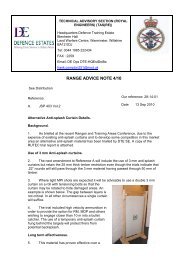
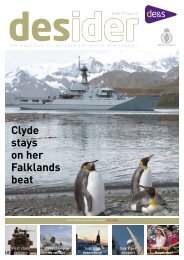
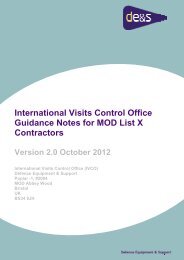

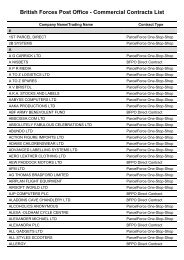


![MAA Regulatory Publications - FAQs PDF [37.3 KB]](https://img.yumpu.com/5906104/1/184x260/maa-regulatory-publications-faqs-pdf-373-kb.jpg?quality=85)
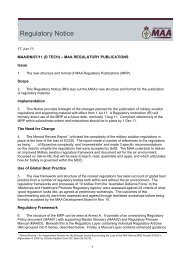
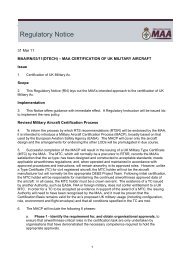
![3750 edition 6 PDF [263.5 KB] - Ministry of Defence](https://img.yumpu.com/5901071/1/184x260/3750-edition-6-pdf-2635-kb-ministry-of-defence.jpg?quality=85)
